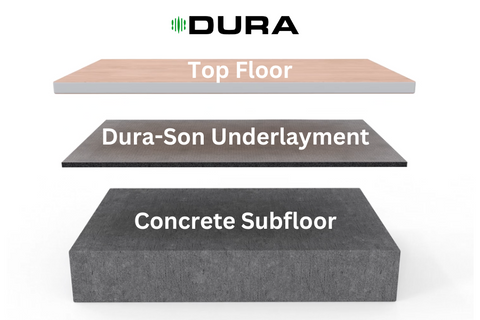The Role of Underlayment in Flooring Projects
When renovating or installing new flooring, there's often a focus on the visible aspects: the type of flooring material, the color, and the pattern. However, one crucial element that often goes unnoticed is the flooring underlayment. Despite its low profile, underlayment plays a crucial role in the performance, durability, and comfort of your flooring. In this article, we'll delve into what underlayment is, its importance, and why it shouldn't be overlooked in your flooring projects.
What is Underlayment?
Underlayment is a layer of material that is installed between the subfloor and the visible flooring material (such as hardwood, laminate, vinyl, ceramic, or carpet).

What Is the Purpose of Underlay?
It serves several important functions:
- Sound Reduction: Flooring underlay helps to reduce noise transmission between floors, absorbing impact, and airborne sound. This is particularly beneficial in multi-story buildings or areas where noise reduction is desired, such as apartments or bedrooms.
- Moisture Barrier: Underlayment can act as a barrier, protecting the flooring above from moisture that may seep up from the subfloor. This is especially important in areas prone to high humidity or moisture, such as basements or bathrooms.
- Subfloor Imperfections: Underlayment provides a smooth and even surface for the flooring material to be installed on, helping to conceal minor imperfections in the subfloor.
- Thermal Insulation: In colder climates, underlayment can provide a layer of thermal insulation, helping to keep the floor warmer and more comfortable underfoot.
What Happens if You Don't Use Underlayment?
Without the proper underlayment, you can expect the following issues:
- Increased Noise: Without underlay, expect more noise from foot traffic, impacting overall comfort and sound quality.
- Moisture Damage: Certain underlays acts as a moisture barrier, so not using it could lead to water damage, especially in humid areas.
- Uneven Flooring: Without underlay, the risk of uneven flooring rises, which can cause tiles or planks to shift or crack over time.
- Reduced Comfort: Underlay provides cushioning, so without it, floors may feel harder and less comfortable underfoot.
How Do I Know if I Need Underlayment?
- Flooring Type: Most types of flooring almost always require underlay to prevent damage over time. Contact Dura Undercushions to help you find the right underlayment for your needs.
- Subfloor Condition: If your subfloor is uneven, has moisture issues, or doesn't insulate well, underlay is highly recommended.
- Building Layout: For multi-story buildings, underlay is essential for reducing noise between levels.
Types of Underlayment
There are various types of underlayment available, each designed to meet specific flooring requirements:
Rubber Underlayment: Rubber underlayment offers superior sound reduction and impact absorption, making it ideal for high-traffic areas or spaces where noise reduction is crucial.
Foam Underlayment: Typically made from foam materials such as polyethylene or polypropylene, foam underlayment is lightweight and easy to install. It provides basic moisture protection and sound reduction. However, it is considered a temporary solution as it gradually compresses and loses its acoustical properties over time.
Cork Underlayment: Cork underlayment is known for its natural properties, including moisture resistance and sound absorption. However, achieving an equivalent acoustical rating to Dura's products requires a thicker layer, leading to increased costs.
Felt Underlayment: Made from recycled fibers, felt underlayment provides good sound absorption and is often used under hardwood and laminate flooring. However, felt’s limited water retention capacity makes it vulnerable to water contamination, which can lead to mold and mildew growth.
Choosing the Right Flooring Underlayment
Selecting the appropriate underlayment involves considering various factors to ensure optimal performance and longevity of your flooring. Here's a step-by-step guide to help you make the right choice:
- Identify Flooring Type: Determine the type of flooring you plan to install (e.g., hardwood, laminate, vinyl, carpet) as this will influence the type of underlayment required.
- Assess Subfloor Conditions: Evaluate the condition of your subfloor, including moisture levels and imperfections. Choose an underlay that provides adequate moisture protection and helps to level out minor subfloor irregularities.
- Consider Location: Consider the location of the installation area. For example, if installing flooring in a high-traffic area or multi-story building, opt for underlayment with superior sound reduction properties to minimize noise transmission.
- Evaluate Environmental Factors: Consider environmental factors such as humidity levels and temperature fluctuations. Choose an underlay with thermal insulation properties, especially in colder climates, to enhance comfort underfoot.
- Budget and Longevity: Factor in your budget and the longevity of your flooring when selecting underlayment. While some options may be more expensive, you're investing in quality to enhance the lifespan of your flooring. Dedicate some time to researching and selecting the option that aligns best with your requirements and preferences.
The Essential Step for Your Next Flooring Project
While underlayment may not be the most exciting aspect of flooring, its importance cannot be overstated. From moisture protection to sound reduction and thermal insulation, underlay plays a crucial role in the performance and longevity of your flooring. By understanding the functions and types of underlayment available, you can ensure that your flooring project is not only attractive but also durable and comfortable for years to come. So, the next time you're planning a flooring project, don't forget about the unsung hero beneath your feet – the underlayment.
Explore Frequently Asked Questions
For additional support, please view our FAQ that addresses common questions about underlayment. This can include compatibility issues, installation advice, and maintenance tips, offering a valuable resource to potential customers.
















